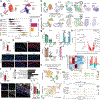Single-Cell and Spatial Transcriptomic Analysis of Human Skin Delineates Intercellular Communication and Pathogenic Cells
- PMID: 37142187
- PMCID: PMC10592679
- DOI: 10.1016/j.jid.2023.02.040
Single-Cell and Spatial Transcriptomic Analysis of Human Skin Delineates Intercellular Communication and Pathogenic Cells
Abstract
Epidermal homeostasis is governed by a balance between keratinocyte proliferation and differentiation with contributions from cell-cell interactions, but conserved or divergent mechanisms governing this equilibrium across species and how an imbalance contributes to skin disease are largely undefined. To address these questions, human skin single-cell RNA sequencing and spatial transcriptomics data were integrated and compared with mouse skin data. Human skin cell-type annotation was improved using matched spatial transcriptomics data, highlighting the importance of spatial context in cell-type identity, and spatial transcriptomics refined cellular communication inference. In cross-species analyses, we identified a human spinous keratinocyte subpopulation that exhibited proliferative capacity and a heavy metal processing signature, which was absent in mouse and may account for species differences in epidermal thickness. This human subpopulation was expanded in psoriasis and zinc-deficiency dermatitis, attesting to disease relevance and suggesting a paradigm of subpopulation dysfunction as a hallmark of the disease. To assess additional potential subpopulation drivers of skin diseases, we performed cell-of-origin enrichment analysis within genodermatoses, nominating pathogenic cell subpopulations and their communication pathways, which highlighted multiple potential therapeutic targets. This integrated dataset is encompassed in a publicly available web resource to aid mechanistic and translational studies of normal and diseased skin.
Copyright © 2023 The Authors. Published by Elsevier Inc. All rights reserved.
Conflict of interest statement
Conflict of Interest
K.T. is a scientific consultant for 10X Genomics, Inc. M.C.G.W is co-founder of PSOMRI Holding AB, PHAMRI NORDEN AB. J.L. is a scientific consultant for 10X Genomics, Inc.
Figures






References
-
- Ascensión AM, Fuertes-Álvarez S, Ibañez-Solé O, Izeta A, Araúzo-Bravo MJ. Human Dermal Fibroblast Subpopulations Are Conserved across Single-Cell RNA Sequencing Studies. J. Invest. Dermatol. 2021;141(7):1735–1744.e35 - PubMed
-
- Bandarchi B, Ma L, Marginean C, Hafezi S, Zubovits J, Rasty G. D2–40, a novel immunohistochemical marker in differentiating dermatofibroma from dermatofibrosarcoma protuberans. Mod. Pathol. Nature Publishing Group; 2010;23(3):434–8 - PubMed
-
- Blanpain C, Fuchs E. Epidermal homeostasis: a balancing act of stem cells in the skin. Nat. Rev. Mol. Cell Biol. 2009;10(3):207–17 Available from: http://www.nature.com/doifinder/10.1038/nrm2636 - DOI - PMC - PubMed
-
- Brocard A, Knol AC, Khammari A, Dréno B. Hidradenitis suppurativa and zinc: A new therapeutic approach - A pilot study. Dermatology. 2007;214(4):325–7 - PubMed
Publication types
MeSH terms
Grants and funding
LinkOut - more resources
Full Text Sources
Medical

